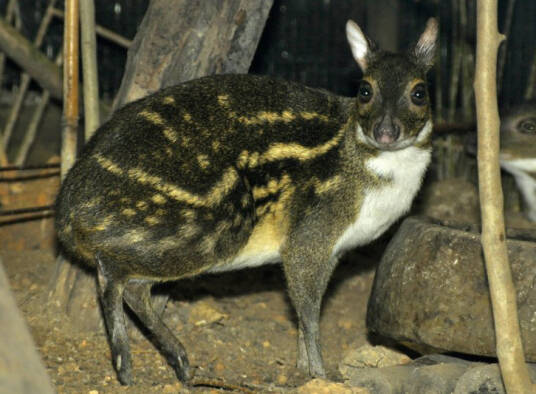Moschiola kathygre
IUCN
LCBasic Information
Scientific classification
- name:Moschiola kathygre
- Scientific Name:Moschiola kathygre
- Outline:Ungulata
- Family:Artiodactylus Tragopanidae Tragopanidae
Vital signs
- length:43-51cm
- Weight:3.1-3.8kg
- lifetime:8-12years
Feature
It is the smallest of the three species in the same genus.
Distribution and Habitat
The range of the yellow-striped chevrotain ranges from the Sinharaja forests of Sri Lanka through the lowlands around Colombo, north to Katagamuwa at the boundary of the dry zone at 6°24′N, 81°25′E, and into the highlands at least to the Kandy region. The riverine forests of the intermediate zone support some of Sri Lanka's wet zone-specific forest birds, and there is no information on whether the wet zone chevrotain uses these habitats. The species persists in the Talangama wetlands near Colombo.
The yellow-striped chevrotain is restricted to the ecological "wet zone" of southwestern Sri Lanka, although further research is needed to distinguish distribution restrictions relative to the spotted chevrotain. It is more abundant in secondary forests than in primary forests, and the preferred habitat is secondary rainforest with immature trees and ground vegetation. The species also occurs in human-occupied environments such as rubber plantations, rice fields, and private
Appearance
The head and body of the yellow-striped chevrotain are 43-51 cm long, with a tail length of 1.6-2.6 cm; males weigh 3.1 kg and females 3.8 kg. The yellow-striped chevrotain is the smallest of the three species in the genus compared to the other two species in the genus. The appearance is also humpbacked; the hind legs are significantly shorter than those of other spotted chevrotains in the genus. The general color is golden brown, with darker calves. There are four or five horizontally arranged yellow spots marking from the shoulders to the hips; usually, the spots in two rows merge to form a more or less complete stripe. There are two thick stripes on the hips and one under the tail. The underside is pale yellow, gradually merging with the brown of the upper body. A clear white stripe extends from below the chin to the throat and along the abdomen. Two pairs of stripes flare out from the central stripe on the throat: one on each side of the chin and one in the middle of the throat. Th
Details
The yellow-striped mouse deer (scientific name: Moschiola kathygre) has no subspecies. It mainly eats fruits that fall from trees, and other foods include young leaves, shrubs, and young branches.

The golden brown body and yellow stripes and markings of the yellow-striped chevrotain visually distinguish it from the other two species in the genus, the spotted chevrotain and the Indian spotted chevrotain, both of which have white spots on their matte gray-brown upper coat. The water deer is superficially similar to the yellow-striped chevrotain, with stripes and spots on its reddish-brown coat; the water deer is larger and easily distinguished by its African distribution.
In an extensive survey of Sri Lanka's wetlands in 2001, the yellow-striped chevrotain was the most common mammal, seen almost every night in many locations, but although it remains common, surveys in subsequent years through 2006 showed that the yellow-striped chevrotain population was declining in the survey area (K.A.I. Nekaris pers. comm. 2008). There have certainly been some dramatic declines locally: for example, the Talangama wetlands near Colombo may have lost more than half of their cover to housing development, and peri-urban species like the yellow-striped chevrotain have suffered heavy infestation by domestic dogs. Unlike small country dogs, Colombo's suburban residents are increasingly keeping large dogs, which make local efforts to protect wild mammals difficult. As wetland forests become increasingly fragmented, the proportion of animals in essentially small and spatially confined areas increases, making them vulnerable to such local pressures.
Listed in the IUCN Red List of Threatened Species in 2014 ver3.1 - Least Concern (LC).
Protect wildlife and eliminate bushmeat.
Maintaining ecological balance is everyone's responsibility!








